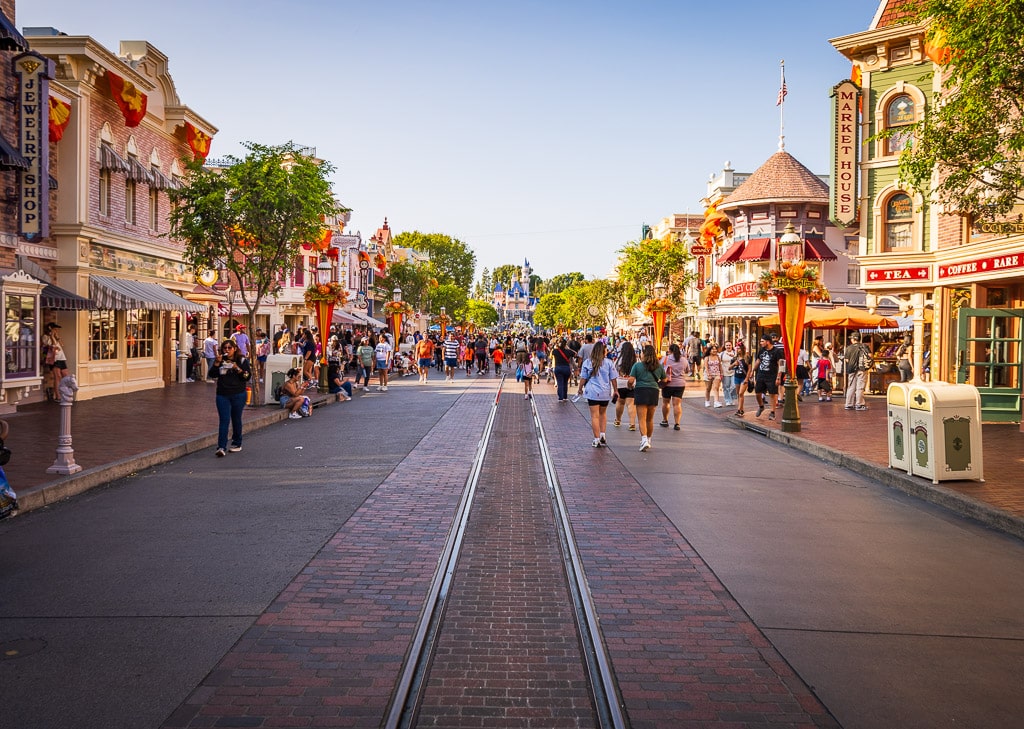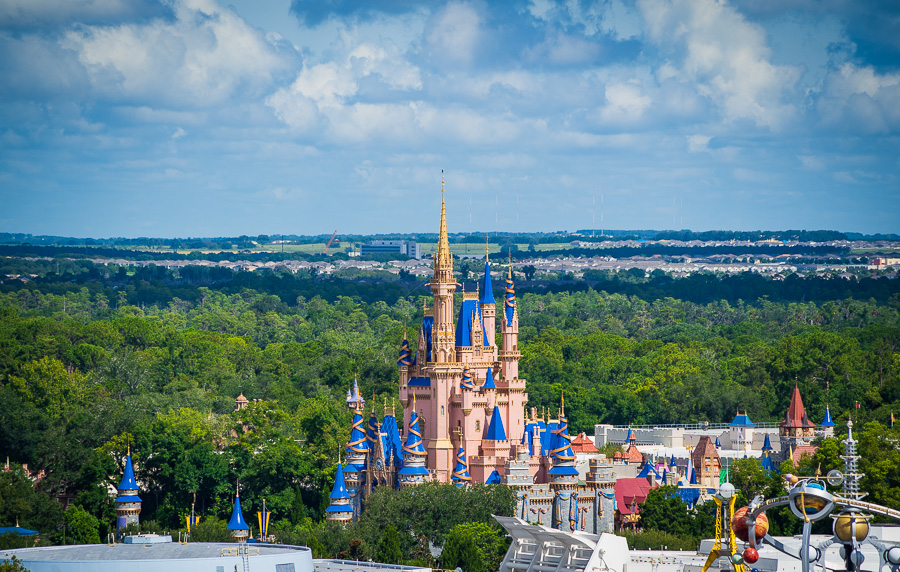
Last year’s attendance report that covers Walt Disney World and Universal Orlando has been released by the Themed Entertainment Association. This post takes a look at the winners and losers in the first almost entirely normal year post-reopening, with commentary about changes and trends for both Central Florida theme park heavyweights.
For starters, the Global Attractions Attendance Report is a collaboration of the Themed Entertainment Association (TEA) and the economics practice at AECOM. This calendar-year study of worldwide attendance is a resource for park operators, developers, and the travel industry. Top worldwide theme parks, amusement parks, water parks, museums, and theme park operators are named, ranked by attendance, and industry trends are identified. The Global Attractions Attendance Report is considered the gold standard within the theme park industry, and TEA is highly credible.
With that said, this report does have some asterisks. Namely, that Universal Orlando and Walt Disney World do not release attendance statistics as part of their earnings or annual reporting. There’s a whole ‘methodology’ section starting on page 80 of the report, which states that numbers are obtained “through a variety of sources, including statistics furnished directly by the operators, historical numbers, financial reports, the investment banking community, local tourism organizations, and professional estimates where necessary.”
The report goes on to explain why most theme park operators voluntarily provide statistics to TEA, and addresses skepticism about inflating or otherwise manipulating statistics. Although there has been some skepticism about Walt Disney World doing precisely this over the years–much like they do with wait times–we doubt that’s happening here for numerous reasons (all explained starting on page 81).
It’s our belief that numbers for both Walt Disney World and Universal Orlando are accurate. Again, the Themed Entertainment Association is the gold standard. Both Disney and Universal are top-tier sponsors of TEA and publicly celebrate annual accolades they receive from the organization. We strongly suspect that both Disney and Universal provide TEA with accurate annual attendance statistics. If you disagree, perhaps this post isn’t for you!
With that preface out of the way, here’s a look at the Top 25 Theme Parks Worldwide:
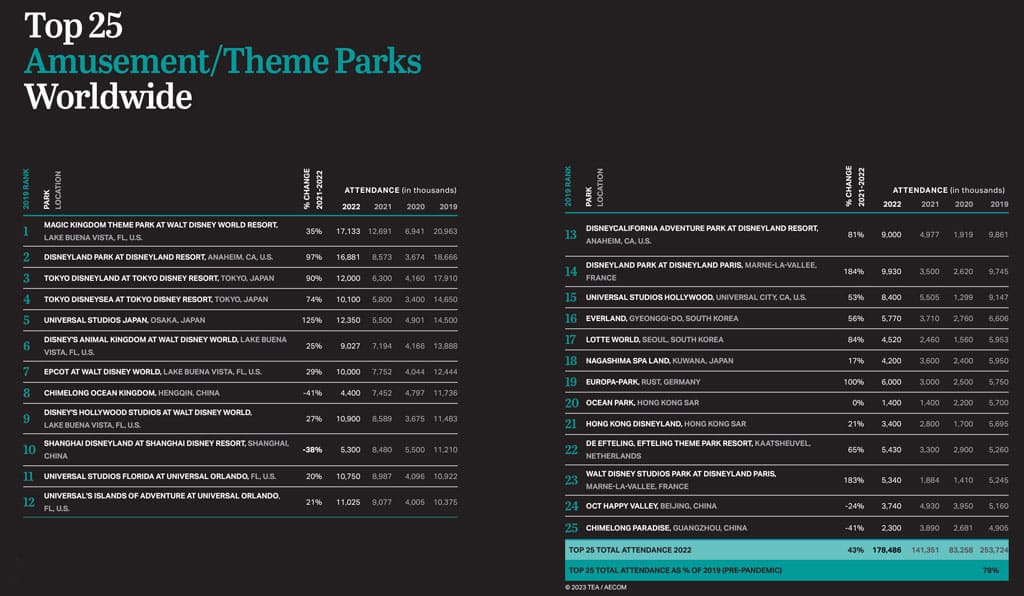
This shows huge rebounds for Disneyland in California, Tokyo Disneyland and DisneySea, and Universal Studios Japan. Conversely, theme parks in China did worse than in 2021. Almost all of this can be entirely explained by COVID closures and subsequent recoveries, which “differed” from Florida. This is already going to be a long post, so we’re not going to fixate on that, though.
Narrowing those numbers to North America, here’s the Top 20:
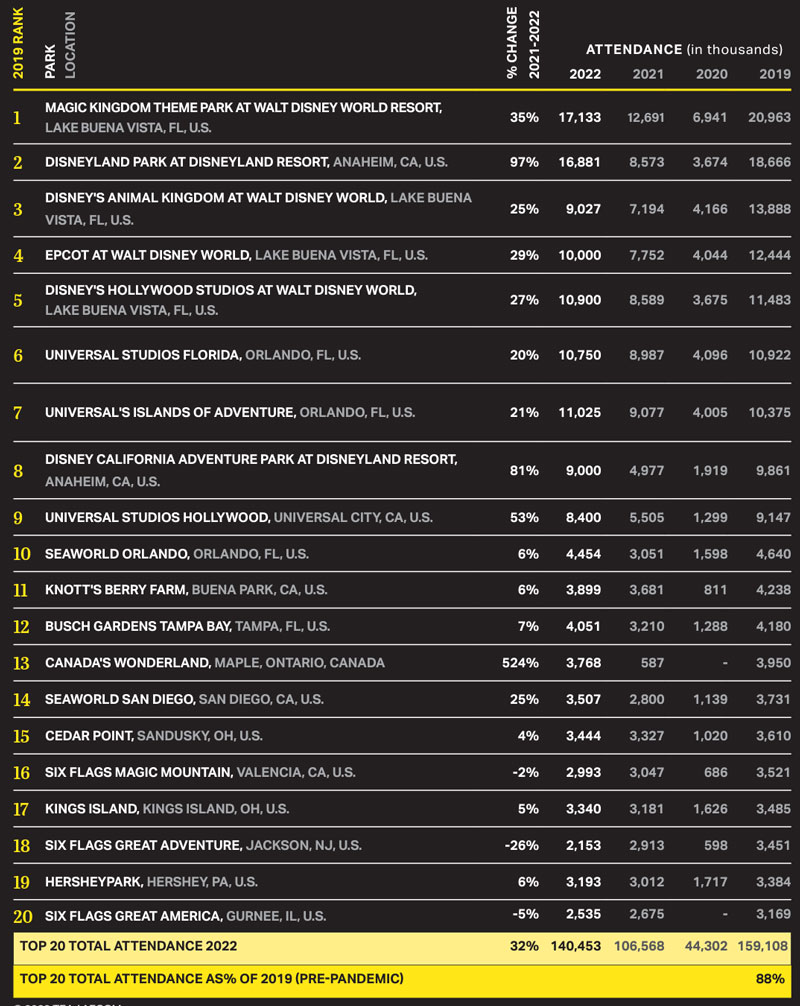
(Note that the rankings above are still ordered by 2019 attendance–look to the right to see 2022 numbers.)
For those strictly interested in Central Florida, here are the attendance numbers and rankings, re-ordered for 2022:
- Magic Kingdom: 17.1 million
- Islands of Adventure: 11 million
- Hollywood Studios: 10.9 million
- Universal Studios Florida: 10.75 million
- EPCOT: 10 million
- Animal Kingdom: 9 million
- SeaWorld Orlando: 4.4 million
- Busch Gardens Tampa: 4.1 million
Every single one of the Disney and Universal parks saw double-digit attendance growth as compared to 2020 or 2021. However, we’re not really concerned with the numbers from those two years. As anyone who follows this stuff knows, 2020-2021 were obvious anomalies with park closures and capacity constraints.
The report itself acknowledges that by retaining the 2019 numbers, and also pointing out that pent-up demand and a return (mostly) to normalcy last year makes the 2019 to 2022 comparison the more relevant one. So that will be our focus, too.
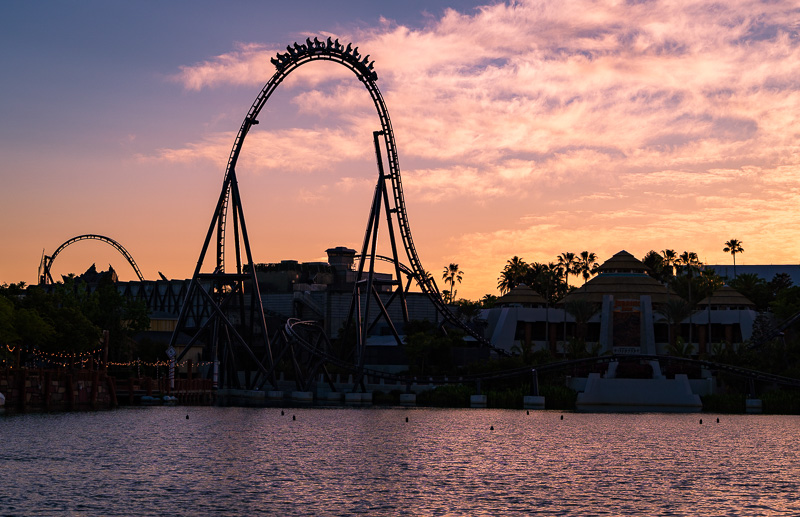
When comparing last year to 2022, attendance growth at Universal Orlando has outpaced Walt Disney World. This actually is not a huge surprise, and is a continuation of a trend first observed immediately after reopening. Universal Studios Florida and Islands of Adventure resumed operations earlier, scaled up faster, and restored normalcy sooner. Perhaps most crucially, Universal aggressively courted Floridians, whereas Disney very much did not.
We’ll circle back to those topics in the commentary, but the bottom line is that Universal’s attendance last year was more on par with 2019 than was the case with Walt Disney World. While Magic Kingdom remains the flagship theme park in the entire world, both Universal Orlando parks are narrowing the gap. In fact, Islands of Adventure saw explosive growth, jumping to the #2 spot (from #7 in 2019), while Universal Studios Florida gained from #6 to #4.

Meanwhile, only Disney’s Hollywood Studios outperformed the industry average with its 2022 attendance numbers as compared to 2019. Even as Magic Kingdom retained its crown, its drop as compared to 2019 was pronounced.
Animal Kingdom was even worse, barely maintaining an edge on Disney California Adventure and Universal Studios Hollywood (the latter will almost certainly surpass it this year thanks to Super Nintendo World). EPCOT remained surprisingly resilient despite the Giant Dirt Pit, but it did add Remy’s Ratatouille Adventure and Guardians of the Galaxy: Cosmic Rewind…and Harmonious, I guess.
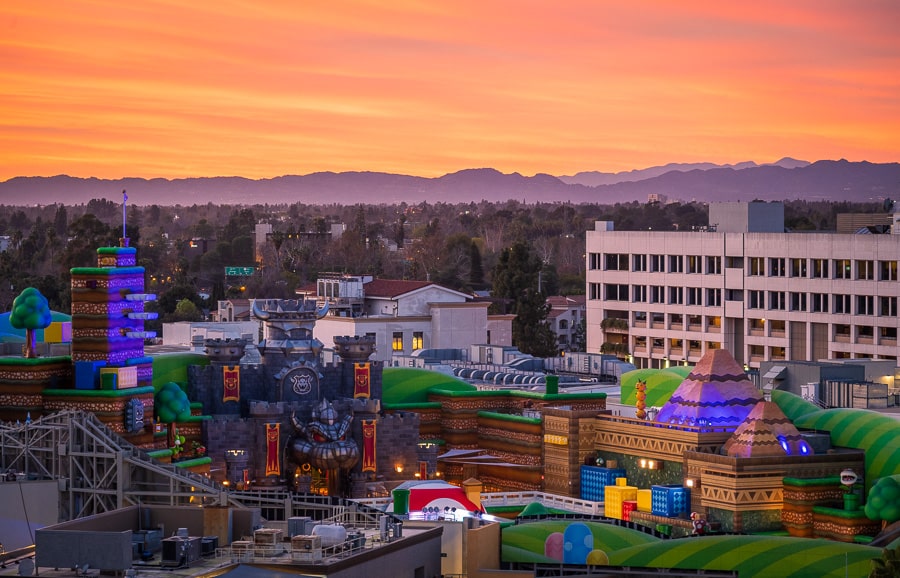
Cutting to the chase, Walt Disney World’s overall attendance was down approximately 20% as compared to 2019. This is a below-average recovery for the industry as a whole in North America, which saw attendance at 88% of 2019 levels. By contrast, Universal Orlando’s two parks were up 2%, driven by tremendous gains at Islands of Adventure.
Consequently, Disney has lost market share in Central Florida. Once adding SeaWorld and Busch Gardens to the mix, Walt Disney World holds roughly 59% of the market–still a dominating number for its 4 parks, but down from 66%. Meanwhile, Universal Orlando is up from 24% to 29%.

Turning to commentary, we’ll attempt to answer the obvious question: what do these numbers mean?
“There are three kinds of lies: lies, damned lies, and statistics.” That is very much apt here, and underscores the point that you could draw a variety of conclusions from these numbers depending upon where your theme park allegiances lie. Some Disney diehards meet push the narrative that this was on purpose, whereas Universal acolytes might claim this means Disney is doomed. Two extremes, neither of which is grounded in reality.
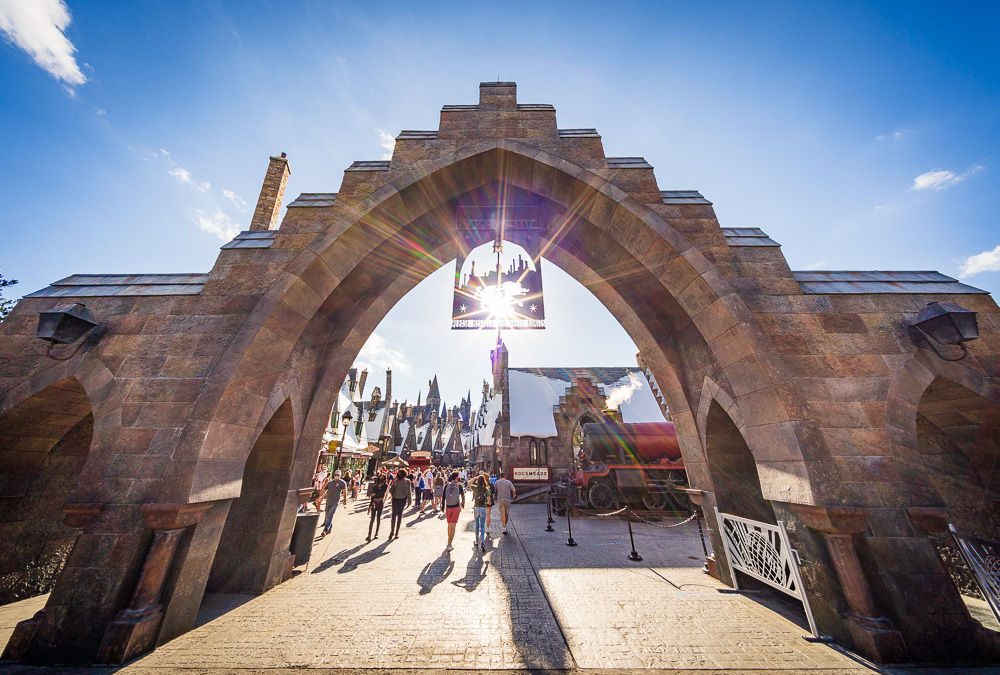
More straightforward interpretation is easy for Universal fans, who can do a victory lap with a face value reading of the higher attendance stats. Islands of Adventure being the lone Central Florida park to surpass its 2019 visitor numbers is a very big deal, and Jurassic World VelociCoaster is the obvious explanation for that.
But it’s not the only one. There’s also Hagrid’s Magical Creatures Motorbike Adventure in the Wizarding World of Harry Potter. That may seem like old news now, but it opened halfway through 2019–meaning that last year was the first full normal year that its impact would’ve been felt.
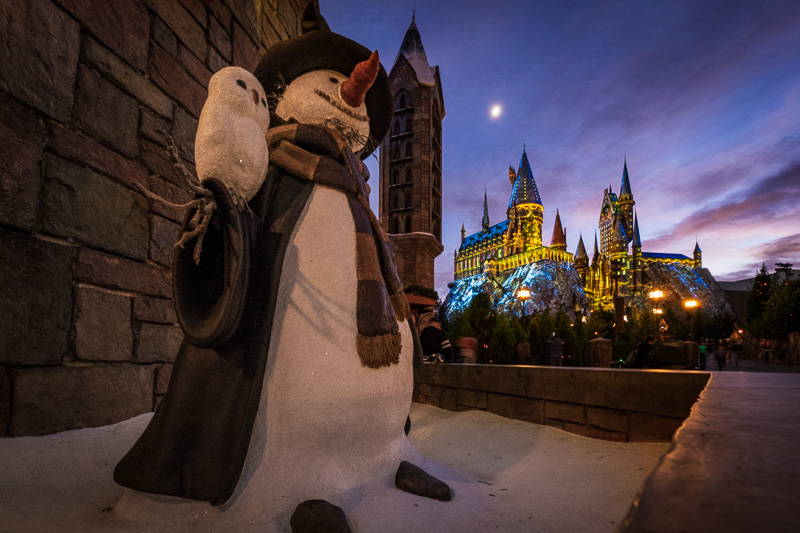
In short, Islands of Adventure’s success is pretty simple: if you build it, they will come. Time and time again, the TEA numbers have borne this out. Animal Kingdom saw a similar explosion post-Pandora and Toy Story Land was big for Disney’s Hollywood Studios. Even last year’s numbers for EPCOT and DHS hint at how Star Wars: Rise of the Resistance and the EPCOT overhaul fueled growth that could’ve been more impressive in a normal environment.
Universal’s impressive post-reopening run is also reinforced by Comcast’s quarterly earnings reports. We don’t cover those here in granular detail, but the parks division there is doing blockbuster numbers in Central Florida and beyond. The success of those parks is a big deal and shouldn’t be minimized. There is literally no way to spin the TEA stats to make Universal look “bad” or like it’s underperforming. So, no lies detected there.
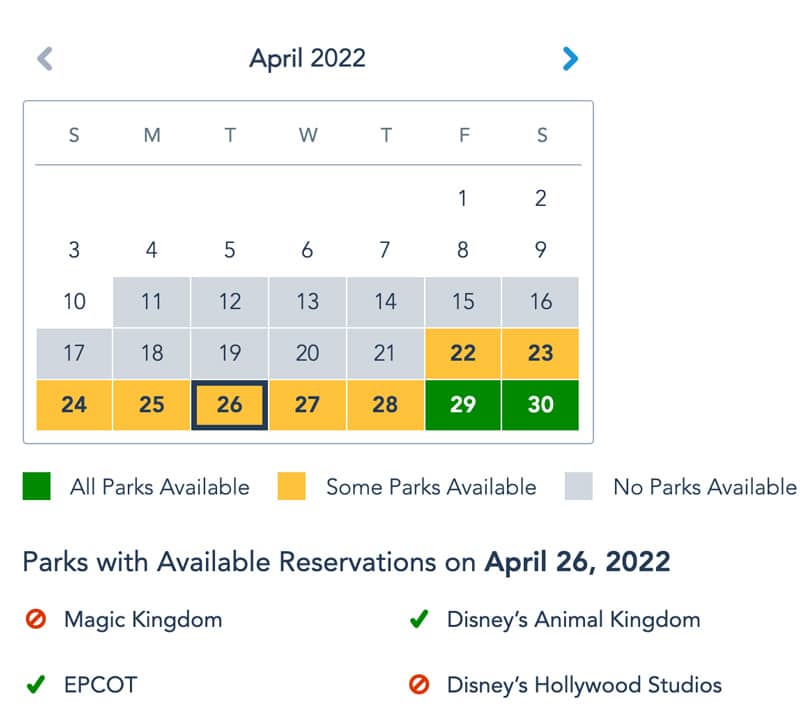
However, there are ways to interpret the results for Walt Disney World to make them look better or worse. Let’s start with the big one, which is that Walt Disney World was still operating with meaningful capacity constraints for a portion of last year. “Meaningful” is the operative word here, which is to say that there were dates where no park reservations were available at all; there were many more when only EPCOT or Animal Kingdom were options.
As discussed previously, the reason for this was mostly attributable to unintentional staffing shortages. (Although mask rules applied for the first couple months of the year, all attendance restrictions for the purposes of health safety were dropped by mid-2021.) For a portion of the year, Walt Disney World also attempted to manipulate attendance, pushing people to Animal Kingdom and EPCOT even when Magic Kingdom and DHS were not at or near capacity.

If you drink the Kool-Aid, you might also be inclined to believe that Walt Disney World reduced attendance on purpose. After all, executives routinely boosted about per guest spending being up 40% and touted their yield management strategy.
There are also a bunch of interviews with Josh D’Amaro and the dearly departed Bob Chapek where a narrative is advanced. During one infamous interview last fall, Chapek claimed that Disney “wants to guarantee a great guest experience no matter when people come…[so that] guests have a magical experience and memories that last a lifetime.”
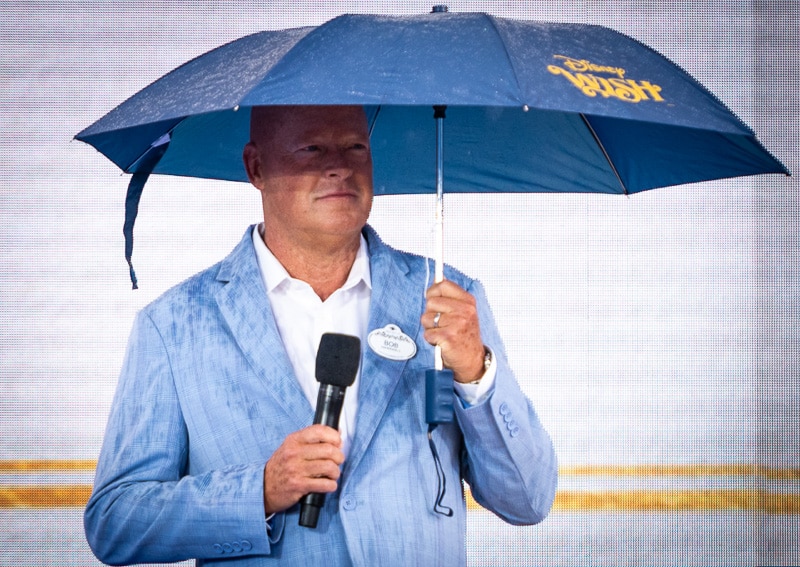
Chapek routinely invoked fictional families from Seattle or Denver to defend the reservation system, claiming: “In a world where we don’t control demand, we’re left with one of two situations. You either let way too many people into the park, where they don’t have a great experience, or you manage it by turning people away at the gate.”
This all sounds well and good if you take it entirely at face value and don’t do any critical thinking. In Disney Doesn’t Want Lower Crowds, we do the opposite and scrutinize those assertions. The title of the post should give away our conclusion. If you visited Walt Disney World last year, there’s a strong chance your anecdotal experience with congestion and feels like crowds likely refutes those claims about “guaranteeing a great guest experience.” Disney largely retiring the reservation system in 2024 should be the final nail in the coffin on these claims.
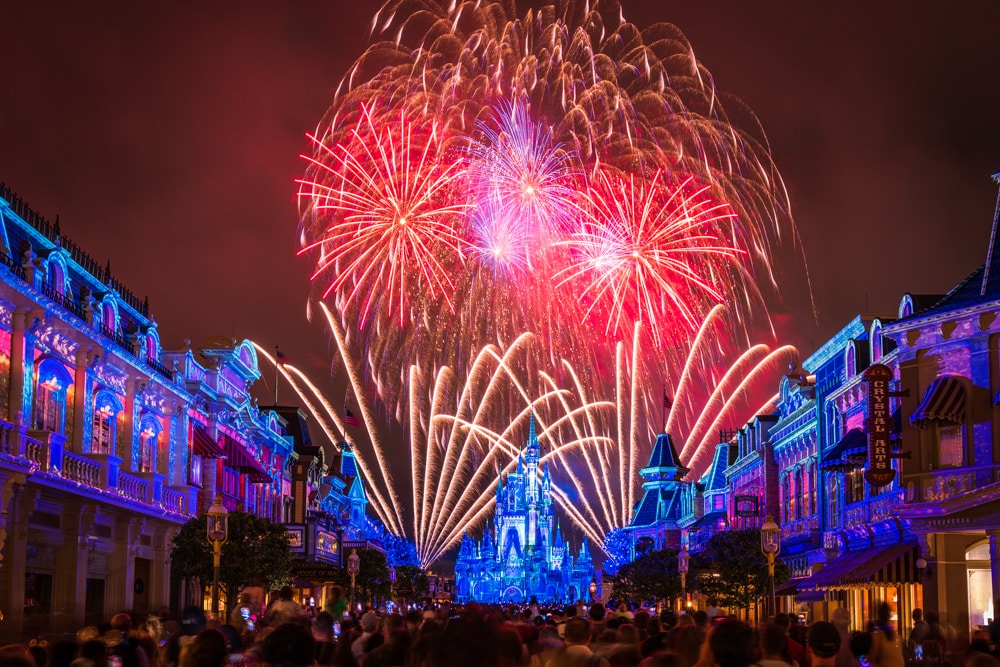
Regardless of the reason, the bottom line is that Walt Disney World was not operating at 100% capacity for at least a portion of last year. There were dates when organic demand exceeded available reservations, and guests were turned away as a result. Consequently, attendance absolutely would have been higher at Walt Disney World if the parks were operated in the same manner as 2019 (or as Universal Orlando).
The degree to which that impacted Walt Disney World and artificially depressed attendance is beyond the scope of the TEA report and is debatable as a result. Our guess is that it had a notable impact on both Magic Kingdom and Disney’s Hollywood Studios, but not EPCOT or Animal Kingdom. Probably not enough to totally eliminate Universal’s market share gain, but to erode it to some degree.
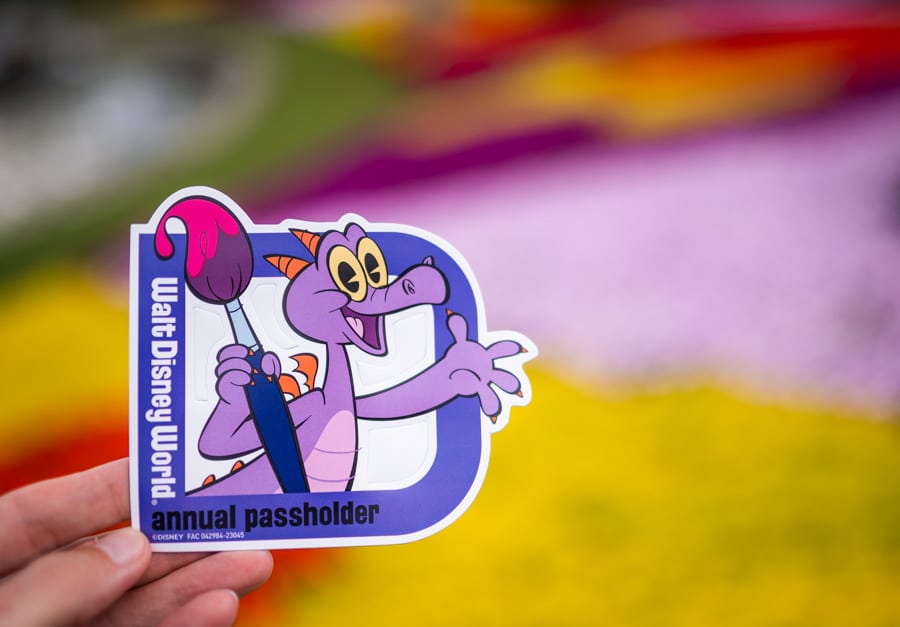
Another undeniably significant factor is Annual Passes. Universal Orlando has gotten aggressive in courting locals over the last few years, an approach that’s evident via promotions, special events, and its Annual Pass program. Although beyond the scope of the TEA numbers, it’s safe to say that Universal outpaced Disney when it came to Annual Pass numbers.
This is an easy conclusion to draw since Walt Disney World suspended sales of most AP tiers for the entirety of last year. This not only would’ve impacted visitation numbers among locals, but likely would’ve pushed a non-trivial number of Floridians to Universal. Obviously, to those only concerned with raw attendance, this is meaningless. The numbers are the numbers.

However, there is more to it than that. As Walt Disney World’s also now dearly departed CFO Christine McCarthy let slip on an earnings call, a higher percentage of Annual Passholders is an “undesirable” guest mix. This is because, on average, APs spend less per visit than tourists. (Without a doubt, this is true–don’t take it as a personal affront and don’t use your personal spending in an attempt to refute this.)
Beyond that, as we’ve pointed out time and time again, Walt Disney World has become a hotel and timeshare business that also operates theme parks. This is to say that resort occupancy is of paramount importance, and Walt Disney World performed incredibly well in that regard. Not only was occupancy high, but it reached those levels with limited discounting. There were also numerous dates when hotels and/or room categories were entirely sold out, suggesting that there was unsatisfied demand and numbers would’ve been higher than there been supply.

The bottom line is that the TEA numbers from last year are undeniably good for Universal Orlando. With its own increased supply of hotel inventory, this is a positive–and important with Epic Universe opening in a couple years.
For Walt Disney World, the stats are much more inconclusive. While we think there has been a lot of spin by Disney about its goals and justifications for the parks, only some of that is bogus. What’s undeniable is that attendance would have been higher with better staffing, Annual Passes, and fewer constraints. It’s also clear that Disney did really well with metrics that matter to the company–per caps and occupancy.
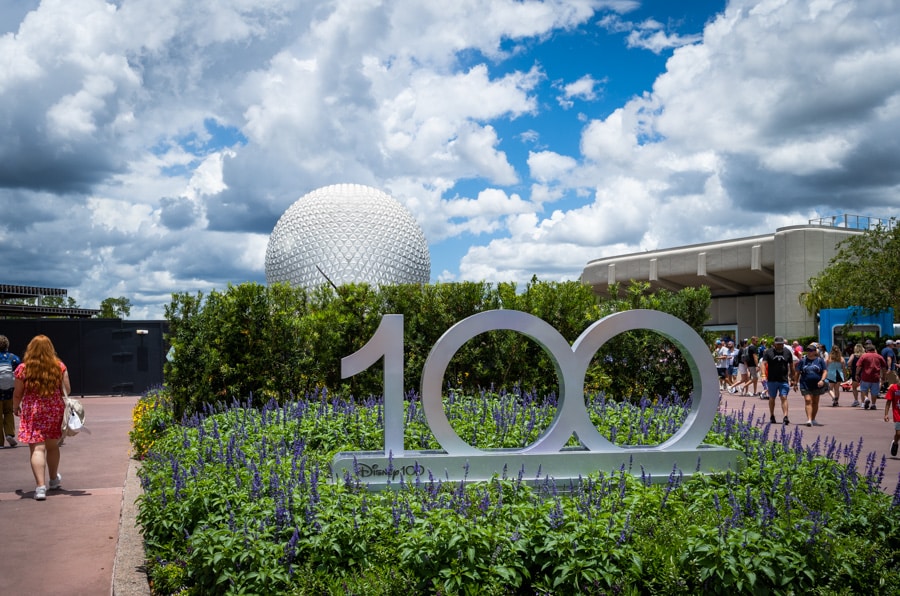
Looking forward, it’ll be incredibly interesting to see how these numbers change for 2023. Thus far this year, wait time data is trending downward for both theme park complexes. It’s becoming increasingly clear that pent-up demand among domestic visitors has been exhausted. Disney executives have proactively warned of a slowdown, attributing this to lapping Walt Disney World’s 50th Anniversary celebration.
The wildcard for Walt Disney World is capacity constraints. Even with wait times down for much of this year thus far, there are a lot of ways that the parks have improved efficiency, which could be contributing to that. Personally, I’m highly skeptical that all of that’s enough to offset the decreases in ‘feels like’ crowds that we’ve observed and wait time data.
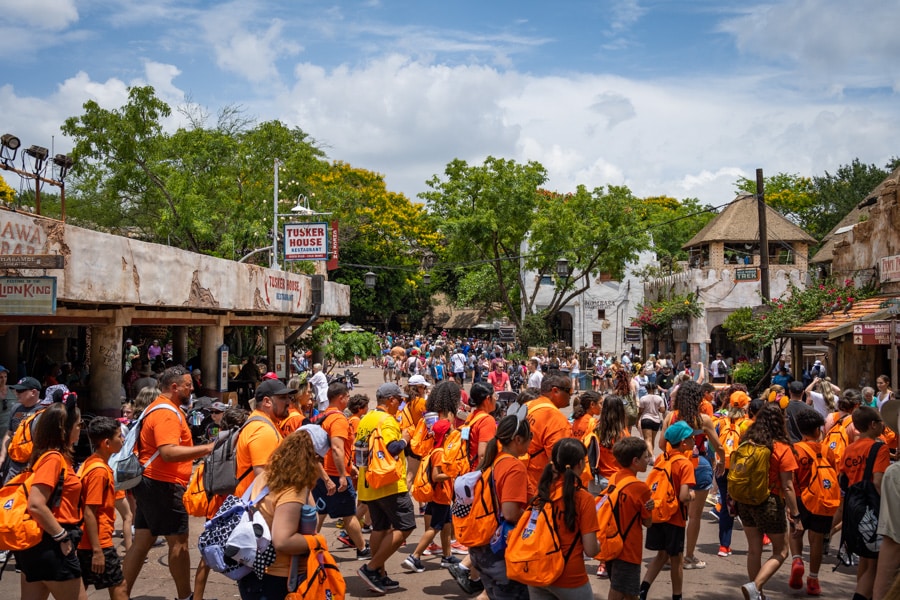
My take is that the lack of pent-up demand is the difference-maker, but who knows. As a result, I’d expect 2023 attendance to be down slightly. That’s just my personal perception, and could be wrong–2023 numbers might still see incremental increases for Walt Disney World. It’s really difficult to assess the impact of capacity constraints on crowds and wait times, so attendance growth is not beyond the realms of possibility.
I don’t recall hearing Comcast leadership speak to reduced revenge travel, but the same is also apparent there. An added wrinkle for Universal is the potential that, after a few years with APs there, some locals could be ‘rotating’ back to Walt Disney World now that APs are available there. So we could see a scenario where Walt Disney World claws back attendance market share even while remaining below its own 2019 high water marks. (I’d bet on this.)
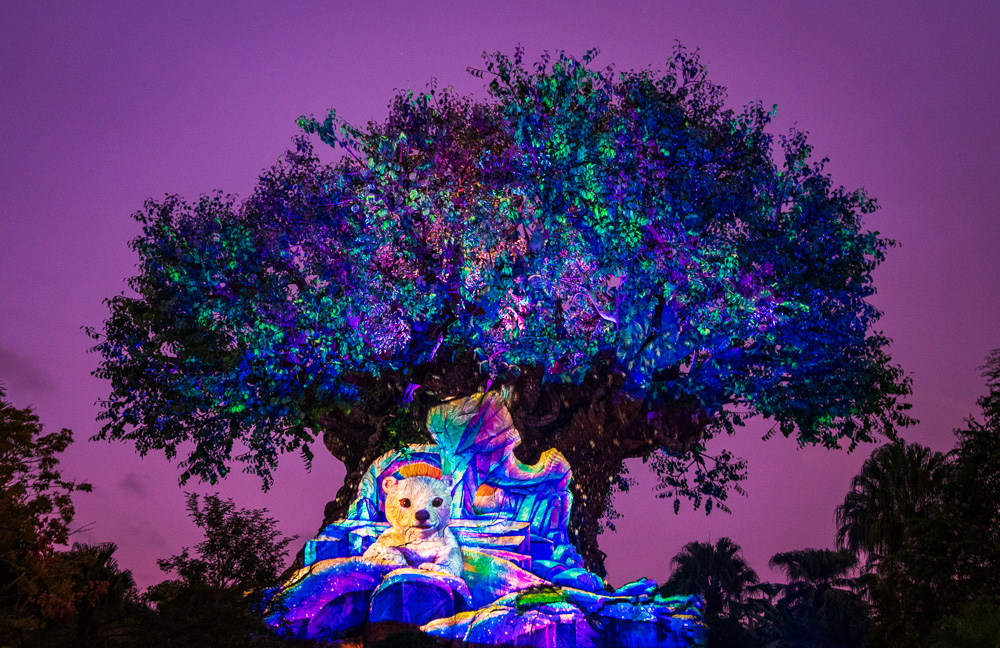
That’s a lot of inconclusive analysis…so are there any definitive conclusions that we can draw? The most interesting aspect of these numbers for me is the ‘downfall’ of Animal Kingdom. This is not a park that had any meaningful capacity constraints at any point last year. Its numbers might’ve suffered a tad due to all of the aforementioned factors, but nothing major.
The stats don’t speak to this, but the situation at Animal Kingdom is likely worse than it appears. Animal Kingdom no longer has a nighttime spectacular, and if observed crowd levels and wait times are any indication, it is doing a far worse job at keeping people in the park late than was the case in 2019. This in turn contributed to increased crowding at Magic Kingdom and EPCOT in the evenings (this probably is not reflected in the numbers, which should use a “first click” methodology to account for attendance).
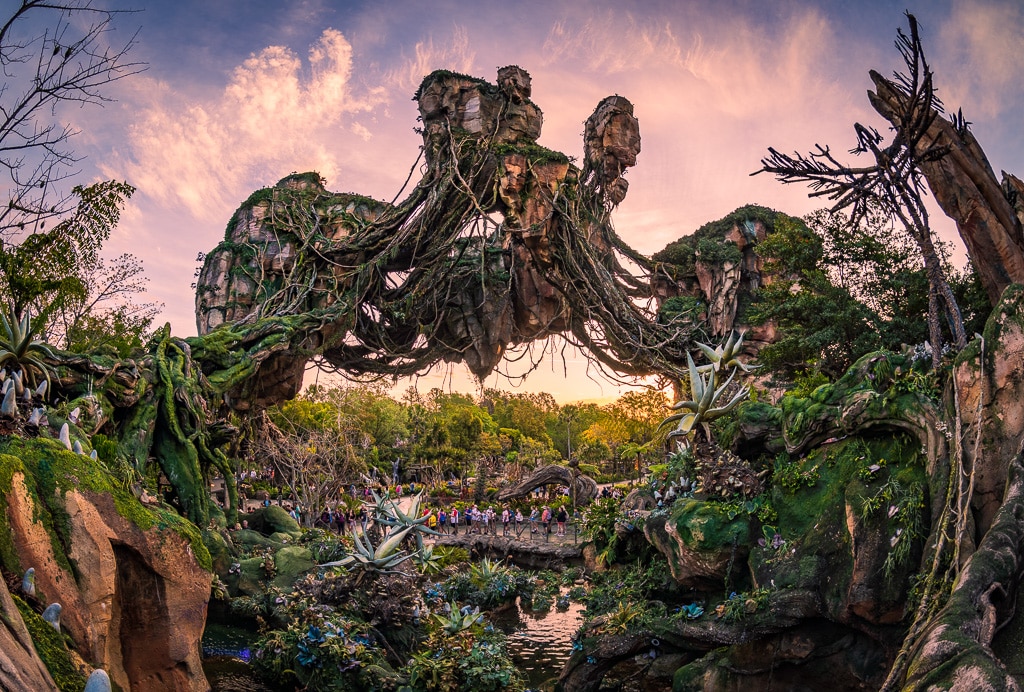
We’ve mentioned this repeatedly in posts about expansion, but this reinforces the reality that Animal Kingdom is the park with the most urgent need for additions. The post-Pandora bump is officially over, and there’s a good chance that Disney’s Hollywood Studios and EPCOT are going to start cannibalizing Animal Kingdom attendance this year and in 2024. (Our guess: Animal Kingdom is the biggest underperformer of Walt Disney World’s parks in 2023 and 2024.)
After seeing the dismal growth for DAK last year, I’m honestly surprised that Disney isn’t acting with a greater sense of urgency. Keep in mind that these numbers are not “news” to Walt Disney World–they would’ve seen these trends emerge over 12 months ago. That Moana and Zootopia tease at the D23 Expo should’ve been an official announcement, and construction should’ve started by now. (Absent the company’s debt and streaming woes, I’m guessing it would’ve.) Failing that, Walt Disney World management should be adding entertainment or doing something.

Looking forward, what’ll be most interesting to watch is what happens with Disney’s Hollywood Studios and EPCOT. These are the two parks with the biggest additions in the last few years. Keep in mind that both Star Wars: Galaxy’s Edge and Mickey & Minnie’s Runaway Railway would’ve been non-factors for 2019 attendance. (Even though Galaxy’s Edge debuted at the end of that summer, Rise of the Resistance didn’t debut until December–that’s when attendance really started to grow.)
Over at EPCOT, we already mentioned Remy’s Ratatouille Adventure, Guardians of the Galaxy: Cosmic Rewind, and Harmonious. Interestingly, none of these things for either EPCOT or DHS really had the kind of appreciable impact on attendance that would’ve been expected in normal times. But these were not normal times. Disney’s Hollywood Studios had the most restrictive capacity constraints, and EPCOT had the Giant Dirt Pit. Accordingly, our expectation is that DHS sees the biggest outperformance in 2023, with EPCOT seeing growth in 2024.
Beyond that, there are the other non-attendance metrics that matter to Walt Disney World. Per guest spending will absolutely start showing drops due to more Annual Passes and increased discounting on resorts, merchandise, and dining. Genie+ and other price increases could partially offset that, but there’s also the elimination of parking fees and other little things. In short, Walt Disney World is “losing” in the metrics that matter most to it even if attendance or market share does improve.

Ultimately, it’ll be an interesting few years to watch attendance (and other) numbers in Central Florida. Although it hasn’t been apparent during this period of pent-up demand, consumers benefit from increased competition. That should start to become more obvious next year and beyond, especially with more hotel inventory throughout the Orlando area (and at Universal, in particular). Obviously, the biggest thing on the “increased competition” horizon is Epic Universe. That new Universal park could amplify emerging trends, and is definitely a positive for guests.
More than anything else, though, the key takeaway from the TEA attendance numbers–and this is something dating back to around 2010–is that building new lands and adding attractions is the surest path to success. Islands of Adventure once again vindicated this approach, and as the park most removed from big expansion, so too did Animal Kingdom. Between all of this and increased bullishness on theme parks by Wall Street, it should be fairly obvious why Bob Iger plans to invest $17 billion in Walt Disney World over the next decade. Suffice to say, 2025 to 2035 should be a great time to be a fan of Orlando theme parks!
Planning a Walt Disney World trip? Learn about hotels on our Walt Disney World Hotels Reviews page. For where to eat, read our Walt Disney World Restaurant Reviews. To save money on tickets or determine which type to buy, read our Tips for Saving Money on Walt Disney World Tickets post. Our What to Pack for Disney Trips post takes a unique look at clever items to take. For what to do and when to do it, our Walt Disney World Ride Guides will help. For comprehensive advice, the best place to start is our Walt Disney World Trip Planning Guide for everything you need to know!
Your Thoughts
What do you think of the TEA Global Attractions Attendance Report? Thoughts on the results for Universal Orlando or Walt Disney World? Any color commentary of your own to add? Do you agree or disagree with our assessments and forward-looking predictions? Any questions we can help you answer? Hearing your feedback—even when you disagree with us—is both interesting to us and helpful to other readers, so please share your thoughts below in the comments!





